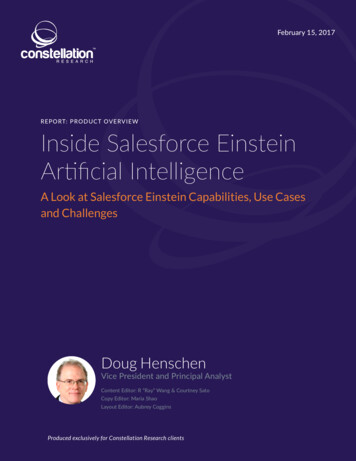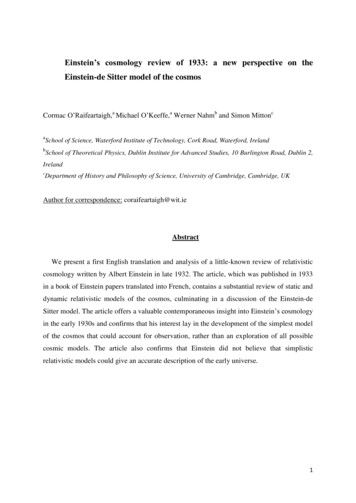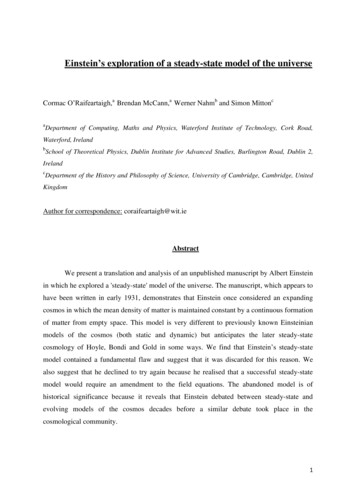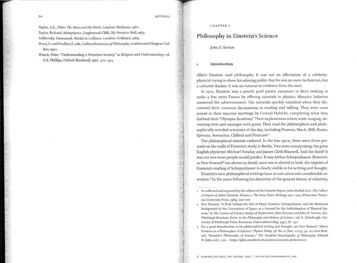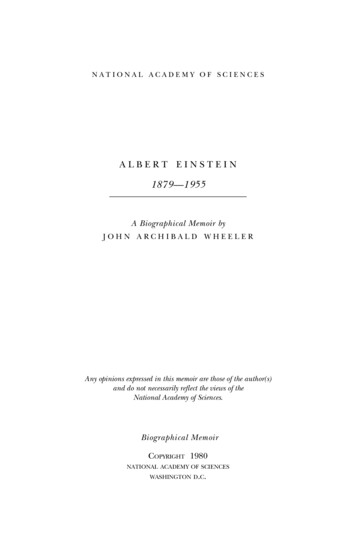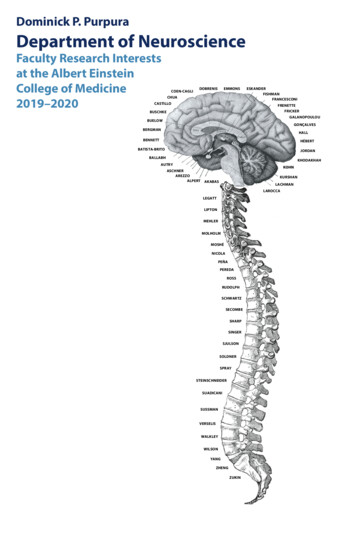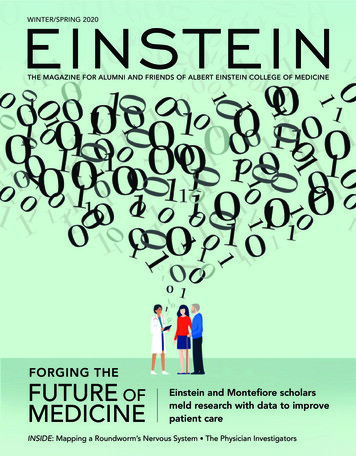
Transcription
EINSTEINWINTER/SPRING 2020THE MAGAZINE FOR ALUMNI AND FRIENDS OF ALBERT EINSTEIN COLLEGE OF MEDICINEFORGING THEFUTURE OFMEDICINEEinstein and Montefiore scholarsmeld research with data to improvepatient careINSIDE: Mapping a Roundworm’s Nervous System The Physician Investigators
A Message from the DeanAs 2019 came to a close,we learned that Einsteinresearchers had secured 178 million in grantsfrom the National Institutes of Health(NIH)—our largest annual total ever(page 14). The grants included fundsto study the Ebola virus and HIV, tocontinue research on neuroscience andgenetics, and to improve health amongminority groups.The year’s end also brought newsthat Philip O. Ozuah, M.D., Ph.D.,has become the new chief executiveofficer of Montefiore Medicine, theumbrella organization for MontefioreHealth System and Einstein (page 2).Dr. Ozuah has decades of experiencein leadership positions at Montefioreand a strong commitment to researchand medical education. He replacesSteven M. Safyer, M.D., who retiredafter 40 years of service to Einstein andMontefiore.Moving medicine forward is thefocus of our cover story (page 22). Thearticle describes a talented group ofEinstein and Montefiore faculty scholarswho epitomize what a learning healthsystem can do: influence complex healthsystems to adapt and change behaviorthanks to evidence obtained from rigorous research and data collection. Thescholars are members of a new centerof excellence established with a 3.3million NIH grant. It is one of only 11such centers in the nation and the onlyone in New York State.Another example of outstandingresearch can be found in the work ofEinstein scientist Scott Emmons, Ph.D.,who has been mapping the nervousEINS TEINScience at the Heart of MedicineWinter/Spring 2020The magazine for alumni, faculty,students, friends, and supporters ofAlbert Einstein College of Medicineand MontefiorePublished byThe Philip and Rita Rosen Departmentof Communications and Public AffairsGordon Earle, Associate DeanOffice of DevelopmentRachelle M. Sanders, Vice President andChief Development OfficerDirector, Science and Research ContentLarry KatzensteinSenior Director, Strategic Communicationsand External RelationsDeirdre BranleyManaging EditorSusan Byrnesystem of the worm C. elegans for thebetter part of two decades. The story ofhis success in completing the first wiringdiagram of an animal’s entire nervoussystem—a major milestone in biology—begins on page 36.For the past 20 years, Einstein’sClinical Research Training Program hastrained dozens of physicians in a varietyof specialties. Five of those scholars talkabout their research (page 16).New funding, new leadership, andnew research add up to bright days aheadat Einstein. I’m looking forward to them.Director, Creative ServicesMarie L. KurtzSenior Director of External Relations,DevelopmentRachel EddeyAssociate Director of External Relations,DevelopmentSean McMahonArt DirectorLorene TapelliniAssociate Art DirectorJeneffer Gonçalves LeeIllustrationsTatyana Starikova HarrisDigital ImagingDonna BrunoPhotographyjtorresphoto.comMultimedia CommunicationsSunita Reed, DirectorAddress correspondence to:Editor, Einstein MagazineJack and Pearl Resnick Campus1300 Morris Park Avenue, Belfer 905Bronx, NY 10461GORDON F. TOMASELLI, M.D.The Marilyn and Stanley M. Katz DeanAlbert Einstein College of MedicineExecutive Vice President, Chief Academic OfficerMontefiore MedicineEmail: letters@einsteinmed.orgWebsite: www.einstein.yu.eduCopyright 2020Albert Einstein College of MedicineAll rights reserved
WINTER/SPRING 2 020IN THIS ISSUEC OV E R S T O R Y22FORGING THE FUTURE OF MEDICINEEinstein and Montefiore scholars meld research with datato improve patient careF E AT U R E S16THE PHYSICIAN INVESTIGATORSEinstein’s Clinical Research Training Program marks20 years of giving doctors the right skills for study success32READY FOR ROTATIONS22A new Transition to Clerkship week helps third-yearmedical students shift from the classroom to the clinic36CONNECTING THE DOTSWith the help of a tiny worm, Einstein scientists completethe first wiring diagram of an animal’s nervous system58SPOTLIGHT: CARING FOR THELITTLEST HEARTSExpectant mothers find expert resources for congenitalheart issues at a new Montefiore center62YOUR IMPACT: UNLOCKING APOTENTIALLY DEADLY DISORDER36Thanks to one family’s philanthropy, researchers aremoving closer to new treatments for Lynch syndromeD E PA R T M E N T S281012485051546669Campus NewsMavens of Medicine: Dr. Jonathan AlpertResearch NotesLab Chat: Dr. Michael BerneyPassionate Pursuits: Artist Adele HeibCrossword: Albert’s PuzzlerMotivations: The Front Line of PhilanthropyContinued Connection: Easing Medical DebtClass NotesA Look BackON THE COVER: A depiction of a learning health system, where researchand data collection are used to help change behavior and more quicklybenefit patients. Illustration concept by Tatyana Starikova Harris.54Visit magazine.einstein.yu.eduor scan codeMAGAZINE.EINSTEIN.YU.EDU 1
CAMPUSNEWSDr. Philip O. Ozuah Named CEO of MontefiorePhilip O. Ozuah, M.D., Ph.D., has been named the chiefexecutive officer (CEO) of Montefiore Medicine, theumbrella organization for Montefiore Health System (MHS)and Albert Einstein College of Medicine. He started his new roleon Nov. 15, 2019, succeeding Steven M. Safyer, M.D., who retiredafter 40 years of service to Einstein and Montefiore.“I look forward tocontinuing to expandinclusive access to stateof-the-art care and tofurthering Montefiore’srole as a global leaderin healthcare andbiomedical research.” — DR. PHILIP O. OZUAH2 EINSTEIN : WINTER/SPRING 2020As CEO, Dr. Ozuah will leadMontefiore’s next phase of growth andevolution as a global healthcare leader,renowned for its excellent medicalschool, groundbreaking research andtechnology, and highly specialized, coordinated care of diverse populations inthe New York region, across the country,and globally.“We are thrilled that Dr. PhilipOzuah, a proven senior executiveand strong strategic thinker, will leadMontefiore into the next decade,” saysDan Tishman, chair of the Board ofTrustees of Montefiore Medicine. “Whatstood out was his impressive record ofsuccess, his intellect and warmth as aphysician, his strength as a leader andmanager, and his deep commitmentto Montefiore’s mission. I’d also like tothank our outgoing CEO, Dr. StevenSafyer, for putting our organization on apath of excellence.”Dr. Ozuah joined Montefiore in1989. “It will be a privilege to lead anorganization with a clear purpose—to heal, to teach, to discover, and toadvance the health of the communities we serve,” he says. “We are anorganization of exceptionally talentedand compassionate people. Workingclosely with the board, I look forwardto continuing to expand inclusive accessto state-of-the-art care and to furtheringMontefiore’s role as a global leader inhealthcare and biomedical research.”Dr. Safyer, who has worked alongsideDr. Ozuah for the past 25 years, says, “Iknow I am leaving our institution in thebest possible hands. I have consistentlybeen impressed by Dr. Ozuah’s strategic vision for the Montefiore HealthSystem. His appointment as CEO willguarantee a smooth transition, and Iknow he’ll continue to uphold the standard of excellence on which Montefiorehas built its reputation.”Gordon F. Tomaselli, M.D., theMarilyn and Stanley M. Katz Dean atEinstein, says, “Dr. Ozuah has a longand storied history at Einstein, and wecould not have hoped for a better choiceto lead our joint enterprise. His vision,commitment to excellence, and dedication to social justice will undoubtedlyprovide the direction and support forEinstein to thrive in the coming years.”Dr. Ozuah previously served as
Photo by Jason Torrespresident of Montefiore and physicianin-chief of the Children’s Hospital atMontefiore (CHAM), where he workedto deliver best-in-class clinical care witha commitment to healthcare access forthe underserved. U.S. News & WorldReport has ranked MHS’s medicalspecialties, under his leadership, inthe top 1% of the nation’s hospitalsand CHAM as one of “America’s BestChildren’s Hospitals.”Dr. Ozuah has a strong commitment to medical education as well asdeep academic medical research expertise, including as a National Institutesof Health–funded investigator and asa professor and the university chair ofpediatrics at Einstein.In these roles, Dr. Ozuah expandedaccess for underserved communities,recruited and cultivated outstandingtalent, advanced programs of excellence,fostered innovations in medical education, and improved financial and operational performance by integrating careacross a rapidly growing and evolvingMontefiore system that sees more than6 million patient interactions a year.He has been recognized regionallyand nationally for excellence in teaching and patient care, including as aninductee into the Alpha Omega AlphaHonor Medical Society and a two-timerecipient of the Academic PediatricAssociation’s prestigious Helfer Awardfor Innovation in Medical Education.Along with receiving various awards forteaching and clinical excellence, Dr.Ozuah has been recognized by ModernHealthcare magazine as one of the“Top 25 COOs in Healthcare.”Philip Ozuah, M.D., Ph.D., with a young patient at the Children’s Hospital at Montefiore.Under his leadership, CHAM was named one of “America’s Best Children’s Hospitals” byU.S. News & World Report magazine.Dr. Ozuah earned his medical degreefrom the University of Ibadan, Nigeria,a master’s degree in education from theUniversity of Southern California, LosAngeles, and a Ph.D. in educationalleadership and administration from theUniversity of Nebraska, Lincoln. Hecompleted his pediatric internship andresidency at Einstein and Montefiore,and his postdoctoral fellowship inmedical education at the University ofSouthern California School of Medicine,Los Angeles.WATCH THE VIDEOView Dr. Ozuah’s INSTEIN.YU.EDU 3
CAMPUS NE WSEinstein Joins With CUNY to Offer M.D./M.P.H.Einstein and the City Universityof New York Graduate School ofPublic Health & Health Policy(CUNY SPH) have collaborated to offerEinstein medical students an opportunityto complete a five-year program resultingin a doctor of medicine (M.D.) degreefrom Einstein and a master’s degree inpublic health (M.P.H.) from CUNY.In its Best Public Health Schools list,U.S. News & World Report ranks CUNYSPH 23rd in the nation—making it thesecond-highest-ranked school in NewYork State.With the October 2019 announcement of its new M.D./M.P.H. program,Einstein joins about 80 medical schoolsacross the nation with similar programsavailable at a single institution or incollaboration with another. Einstein firstoffered this opportunity to the Class of2023 and made it available to all subsequent incoming M.D. students.Physicians with M.P.H. degrees workin a variety of settings, including departments of health, nonprofit organizations,and research institutions.Earning a separate M.P.H. degree typically takes two years. The new program’sstructure will allow Einstein students tocomplete both their M.D. and M.P.H.degrees in five years.DoSA Marks 50 Years With Opioid ConferenceScientists, clinicians, policymakers, and community activistsdiscussed opioid-use disorder’spast, present, and future at a daylongconference at Einstein and Montefiorein September 2019 featuring a keynoteaddress by Michael Botticelli, M.Ed.,former director of the Office of NationalDrug Control Policy under PresidentBarack Obama.The event, “On the Front Lines ofthe Opioid Epidemic,” highlightedEinstein and Montefiore’s leadership inthe field of opioid-use disorder, frombasic and clinical research to communitycare and outreach services. It also markedthe 50th anniversary of the Division of4 EINSTEIN : WINTER/SPRING 2020Substance Abuse (DoSA), which wasestablished as an Einstein methadonetreatment program and—as a part ofMontefiore—has evolved into a leadingprovider of comprehensive outpatientcare at multiple locations for more than3,400 adults in the Bronx.Einstein and Montefiore researchersand clinicians discussed recent discoveries, from neuroscientific advanceson the brain’s role in reward-seekingbehavior to effective, evidence-basedopioid-use-disorder treatment strategies.Panel discussions also addressed publicpolicy concerns and the need for reducing the stigma of addiction and structural barriers to care.Joyce Lowinson, M.D., was honored forher decades of service to DoSA. With herare Jonathan Alpert, M.D., Ph.D., left, andMontefiore CEO Philip Ozuah, M.D., Ph.D.
3 Physicians Win National HonorsDr. Irene Blanco NamedHispanic Health LeaderDr. Cristina Gonzalez Gets New Investigator AwardCristina Gonzalez, M.D. ’04, an associate professor ofmedicine at Einstein, an internist at Montefiore, and anactivist in the fight against health disparities, received the2018 New Investigator Award from the Association ofAmerican Medical Colleges in November 2019.The award was given in recognition of the publicationof a paper for which she was the lead author, “How toMake or Break Implicit Bias Instruction: Implications forCurriculum Development,” in a November 2018 onlinesupplement to the journal Academic Medicine.Implicit bias refers to subconscious, unintentional assumptions about other people, which can often lead to disparities in healthcare for disadvantaged populations.Many medical schools offer their students instruction about avoiding bias, andDr. Gonzalez has made significant contributions to such programming at Einstein.Teachers, however, have not been on the receiving end of these educational efforts,and in her paper Dr. Gonzalez explores faculty members’ personal challenges, therole of institutions, and strategies for helping educators.Her goals are to see the topic recognized as a faculty-development priority and tochange the culture around implicit bias in medical education and healthcare.Mentor Award Goes to Dr. Michal MelamedMichal Melamed, M.D., M.H.S., was given the Distinguished Mentor Award by the American Society ofNephrology (ASN) at its annual Kidney Week meeting inNovember 2019. Earlier in the year, Dr. Melamed, associate professor of medicine and of epidemiology & population health at Einstein and a nephrologist at Montefiore,also received a mentoring award from Einstein’s department of medicine. Since joining the faculty at Einstein,she has mentored multiple junior faculty members, fellows, residents, and Einstein medical students.Several of Dr. Melamed’s colleagues nominated her for the ASN mentorshipaward. They lauded her reputation as a national expert in studying risk factors forchronic kidney disease progression and praised her drive, enthusiasm, patience, andadvocacy for her mentees. “I try especially to mentor women and people who maybe underrepresented in medicine because I think that it’s important to get more people with diverse backgrounds into research,” Dr. Melamed says. Her research interests include the epidemiology of, and ethnic and racial disparities in, chronic kidneydisease, vitamin D deficiency, and the health consequences of metabolic acidosis.Last November, the NationalHispanic Health Foundation (NHHF)recognized Irene Blanco, M.D. ’04,M.S., associate dean for diversityenhancement at Einstein and arheumatologist at Montefiore, withits Hispanic Health LeadershipAward.The NHHF is part of the NationalHispanic Medical Association, anonprofit organization that represents 50,000 licensed Hispanicphysicians in the United States andis a partner organization of theNational Institutes of Health.Dr. Blanco, associate professor ofmedicine at Einstein and director ofthe Lupus Clinic at Montefiore, waschosen for the honor because ofher leadership in improving healthcare. She works with the AmericanCollege of Rheumatology’s LupusInitiative on information sheets distributed to Hispanic patients. Withthe help of a two-year federal grant,she is recruiting more minoritypatients for lupus clinical trials. Thedisease is two to three times moreprevalent among women of color,particularly Hispanics, than amongCaucasian women.MAGAZINE.EINSTEIN.YU.EDU 5
CAMPUS NE WSEnhancing Einstein, Inside and OutFrom new outdoor benches and lighting to completelyrefurbished lobbies, several projects begun in 2019 aremaking Einstein a better place to work and live.“Upgrading and modernizing our grounds and facilitiesand investing in enhancements to our campus community area priority,” says Gregg Tarquinio, Einstein’s associate dean foradministration and finance.The renovations have included adding new furnitureand lighting to student housing, the Belfer EducationalCenter, and the D. Samuel Gottesman Library study area.Necessary structural improvements have involved upgradingelevators and replacing air conditioners in several buildings.Audiovisual equipment has been replaced in auditoriums,lecture halls, and conference rooms; wireless and wirednetworking technology is currently being overhauled campuswide; and additional automated external defibrillator unitshave been placed in all buildings.In addition to those projects, the Clinical ResearchCenter has moved from the Jack D. Weiler Hospital andthe Leo Forchheimer Medical Science Building to spacewithin the Van Etten Building, and the Magnetic ResonanceResearch Center has received a new 3T magnet and had itsinfrastructure upgraded.OPPOSITE PAGE, at top: First-year medical students assemble before class in the renovated Belfer basement. Middleleft: First-year medical student Christina Pil does somelaptop work on a new couch in the Belfer basement. Middleright: Inspiring words from Albert Einstein decorate theBelfer lobby. Two bottom photos: Students convene on newcouches in the expansive 1925 student housing lobby.6 EINSTEIN : WINTER/SPRING 2020Photos by Jorg MeyerTHIS PAGE, at top: The renovated Belfer lobby welcomesvisitors with new Einstein signage and terrazzo flooring.At left: New tables and chairs adorn the lobby at the1925/1935 Eastchester Road Residence Complex.
MAGAZINE.EINSTEIN.YU.EDU 7
MONTEFIORE AND EINSTEINMAVENS OF MEDICINEEnsuring Diversityin Mental HealthResearchQ&A withDr. Jonathan AlpertJonathan E. Alpert, M.D., Ph.D., is theDorothy and Marty Silverman Chair inPsychiatry and chair of the departmentof psychiatry and behavioral sciences at Einsteinand Montefiore. Dr. Alpert arrived in 2017 fromMassachusetts General Hospital, where he wasassociate chief of psychiatry and director of thedepression research program. He was also the firstincumbent of the Joyce Tedlow Chair in the fieldof depression studies at Harvard Medical School.8 EINSTEIN : WINTER/SPRING 2020
Why did you specialize inpsychiatry?Was the Einstein and Montefioreconsolidation an attraction?It is a remarkable field that spans basicneuroscience, clinical pharmacology, andsocial, emotional, and cognitive development. It engages fundamental questionssuch as what it means to be human andto live a good life. On a more personallevel, I think clinicians are drawn todifferent forms of human suffering. Aslong as I can remember, I’ve been drawnto suffering related to psychiatric conditions and to people traditionally marginalized in society and in healthcare due tomental illness or addiction.Yes, very much. Among other things itcreated the opportunity for psychiatryto partner with Einstein’s exceptionaldepartment of neuroscience—one of theworld’s first freestanding neurosciencedepartments. Working with neuroscience, we’ve launched PRIME (PsychiatryResearch Institute at Montefiore andEinstein) in a refurbished research spaceon the fourth floor of Van Etten.What influenced you to leaveBoston?My wife and I were empty nesters, withtwo young-adult sons off at school, sowe were at an inflection point when Iwas contacted about the departmentchair opportunity here. I was gratefulfor the wonderful career, outstandingcolleagues, and formative opportunitiesI’d had in Boston. But with, I hope, adecade or more of active professionallife ahead, it seemed like an ideal timeto make a meaningful contributionelsewhere.Photo by Jason TorresWere you familiar with Einsteinand Montefiore?I knew of Einstein and Montefiore byreputation and of Montefiore’s leading national role in behavioral-healthintegration in primary care and schoolhealth. And when I came here forinterviews I was inspired by what Isaw: a special place where commitments to advancing social justice andscience—two values very important tome—are seamlessly interwoven and fullyembraced across campuses.Einstein Student Mental Health Center,which provides expert, accessible evaluation and treatment for medical and graduate students on the Einstein campus.Do people in the Bronx faceunique mental health challenges?Many patients we see have experiencedsome kind of major trauma. It might bephysical violence, poverty, housing insecurity, dislocation from their country oforigin—significant burdens that increasethe risk of mental illness and addiction.What does PRIME do?PRIME will allow us to greatly increaseclinical and translational research in psychiatry. Our health-equity research program within PRIME will enable us tostudy how factors such as socioeconomicstatus, ethnicity, and sexual or genderorientation affect mental health outcomes. PRIME brings together clinicallyfocused people like me and outstandingbasic scientists, many of whom share adevotion to unraveling the mysteries ofmental illness. We’re fortunate that ourclinical programs serve diverse communities that are exceedingly underrepresented in studies on mental illness andaddiction. We have the obligation toensure that these diverse voices are betterrepresented in psychiatry research.What other programs have youstarted?We have many new programs, thanksmainly to strong interdepartmentalcollaborations. We’ve worked with theChildren’s Hospital at Montefiore emergency department to develop a specialized pediatric psychiatry emergencyservice to improve the care of childrenpresenting with psychiatric problems.We’ve also joined with the dean’s officeand Montefiore leadership to create theCould more be done to preventmental health problems fromdeveloping?Certainly. We can do more to impartpractical coping and resilience skills inour school systems and to support goodparenting skills, particularly for parentswho’ve experienced early life adversityand trauma and aren’t fully equippedto be the parents they want to be. Weneed to enhance access to affordable,high-quality mental health services toaddress problems early on before theybecome severe and chronic.What has been the main focus ofyour research?I’ve been interested in mood disorders,particularly treatment-resistant majordepressive disorder. Available therapiesdon’t work well enough for far too manyindividuals, and those gaps in knowledgeand treatment continue to motivate me.Have you read any good bookslately?I’m now reading Sapiens: A Brief Historyof Humankind, by Yuval Noah Harari. Itraises fascinating, provocative questionsabout our improbable ascendancy as thedominant species on the planet.MAGAZINE.EINSTEIN.YU.EDU 9
RE SE ARCHNOTESPhoto by Neville Elder/CORBIS/Corbis via Getty ImagesFirefighter Heart Disease Linked to WTC ExposureAstudy of nearly 10,000 NewYork City firefighters has foundthat exposure to 9/11 WorldTrade Center (WTC) dust is associatedwith a significantly increased long-termrisk of cardiovascular disease (CVD).The study was conducted by researchers at Einstein, Montefiore, and the FireDepartment of the City of New York(FDNY). Firefighters who arrived firstat the WTC site—when the airbornedust was thickest—have a 44%increased risk ofCVD comparedwith those whoarrived later in theday. The studywas published inSeptember 2019in JAMA NetworkOpen.“The increasein risk was significant, even taking into account knownCVD risk factors such as age, hypertension, elevated cholesterol, diabetes, andsmoking,” says study leader David J.Prezant, M.D., professor of medicine atEinstein, a pulmonary disease specialistat Montefiore, and chief medical officerof the FDNY.This study’s finding of an increasedrisk of CVD with WTC exposure—aswell as the researchers’ earlier studies identifying an increased risk forautoimmune rheumatologic diseasesand for a blood-cancer precursor thatcan lead to the cancer multiple myeloma—“highlights the need to add thesehealth conditions to the list of WTCrelated diseases that are coverable underthe James L. Zadroga 9/11 Health andCompensation Act,” Dr. Prezant adds.Other studies have linked both acuteand prolonged exposure to air pollutionto CVD. The authors noted that thefirefighters’ exposure to dust and products of combustion could have triggeredpersistent disease processes involvingchronic inflammation that increasedtheir risk for CVD years later.“Our results emphasize why it iscrucial to monitor the long-term healthof anyone exposed to massive environmental disasters, even many years afterthe event,” says co–lead author RachelZeig-Owens, Dr.P.H., research assistantprofessor of epidemiology & populationhealth at Einstein and an epidemiologistat Montefiore and the FDNY.Promising Treatment for Cancer-Caused AnemiaIn myelodysplastic syndrome (MDS),a cancer of the bone marrow, anemiaoccurs because the proliferation ofabnormal blood cells leaves people withtoo few normal ones. An experimentalcancer drug called galunisertib mayoffer a way to treat anemia in low- tointermediate-risk MDS patients withoutthe need for blood transfusions.The findings, published in September10 EINSTEIN : WINTER/SPRING 20202019 in Clinical Cancer Research, comefrom an international phase 2 clinicaltrial conducted at 14 centers in Italy,Spain, and Germany. The study’sprincipal investigator was Amit K.Verma, M.B.B.S., professor of medicineand of developmental and molecularbiology at Einstein and director ofthe division of hemato-oncology atMontefiore.Dr. Verma and colleagues developedgalunisertib using tumor samplesfrom patients at Montefiore. The druginhibits a molecule called ALK5 thatplays a role in activating defective MDSstem cells.The research was co-led by ValeriaSantini, M.D., associate professor ofhematology at the University of Florencein Italy.
Unexpected Origin of Hospital InfectionsThe intestinal bacteriumClostridium difficile can be lethaland is difficult to treat. Each yearit sickens about half a million Americansand causes about 30,000 deaths. C. diff,as it’s called, has long been thought toinfect people hospitalized or in otherhealthcare facilities. But in a study published in December 2019 in InfectionControl and Hospital Epidemiology,researchers report that nearly one in10 patients admitted to the hospitalis already infected with C. diff, eventhough they do not have symptoms.The researchers, led by Sarah Baron,M.D., M.S., tested 220 incoming hospital patients with no symptoms of C. diffand found that 21 were infected. Withinsix months, 38% of thosecarriers progressed tosymptomatic C. diff ; bycontrast, only 2% of initially noninfected patientsended up with symptomatic C. diff.The U.S. Centersfor Disease Control andPrevention considers theprospective identificationof C. diff carriers a “supplemental intervention”but doesn’t recommendit as a prevention strategy. This studysuggests that prospectively identifyingand treating carriers could help preventC. diff–related illnesses and deaths. Dr.Baron is an assistant professor of medicine at Einstein and director of inpatientquality improvement in the departmentof medicine at Montefiore.Growing Retinas in the LabIt’s not easy to study the retina andits diseases—in particular, maculardegeneration, the leading cause ofirreversible vision loss in people over60. The retina’s macula, a small spot inthe center of the retina where vision isthe sharpest, is crucial for both centralvision and visual acuity. It is also rich incones, the photoreceptors that enablecolor vision. But the macula is unique toprimates, and nonhuman primates areextremely costly to study.Now, as reported in May 2019 in theProceedings of the National Academy ofSciences, Einstein scientists have for thefirst time successfully produced conerich retinal organoids that resemble thehuman macula. The research was led byWei Liu, Ph.D., assistant professor ofCones (red) and rods (green) in a retinalorganoid cultured for about 7 months.ophthalmology and visual sciences andof genetics at Einstein.Organoids—tiny clumps ofcells grown in tissue culture thatresemble human tissues or organs—have emerged as powerful models forstudying human development anddisease. They are derived from stemcells—in this case, human embryonicstem cells, which Dr. Liu and his colleagues coaxed to develop into retinalorganoids.Cone-rich retinal organoids couldbe a valuable resource for studying thebiology of the human retina and mayhelp reveal the molecular glitches thataffect the retina, leading to treatmentsfor macular degeneration and otherblinding retinal diseases.WATCH THE VIDEOSee photoreceptor cells in aretinal organoid come to life in TEIN.YU.EDU 11
RE SE ARCH NOTE SLab ChatMichael Berney, Ph.D., is a microbiologist who studies Mycobacteriumtuberculosis (Mtb), the microbe that causes TB. Dr. Berney wasborn in Switzerland, where he studied environmental sciences andmicrobiology at the Swiss Federal Institute of Technology in Zurich, which wasalso Albert Einstein’s alma mater. After completing a postdoctoral fellowshipin bacterial bioenergetics in New Zealand, he came to Einstein to collaboratewith TB pioneer William Jacobs, Ph.D. Dr. Berney joined the Einstein facultyin 2016, where he is an assistant professor of microbiology & immunology.How did you become interested inmicrobiology?For TB researchers, what is specialabout Einstein?During my education in Switzerland, Iwas a visiting student in environmentalsciences at the Massachusetts Institute ofTechnology, and we studied a pollutedlake outside Boston. Industrial toxicchem
Clinical Research Training Program has trained dozens of physicians in a variety of specialties. Five of those scholars talk about their research (page 16). New funding, new leadership, and new research add up to bright days ahead at Einstein. I'm looking forward to them. EINSTEIN Science at the Heart of Medicine Winter/Spring 2020



